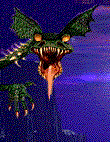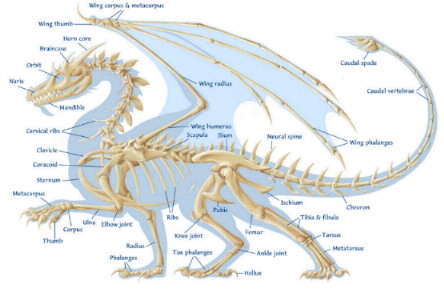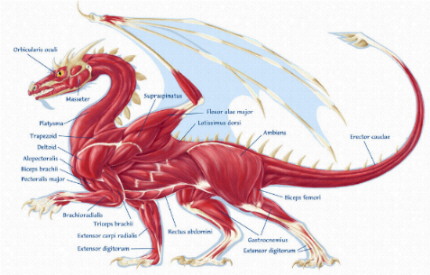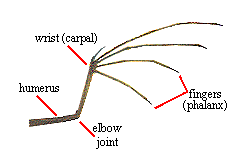
Which do you fancy?

 Which do you fancy? |  |
 |
 |
 |
 |

 The Western dragon Eudraco magnificus occidentalis has a sturdy skeleton structure. Large head, long neck, broad shoulders, thick legs, strong tail, and very large wings. The dragon's bones are very strong, but hollow and light. A dragon's jaw is large to accommodate the very strong muscles around it. The dragon is able to dislocate its jaw, as some snakes are able to do, to grab large objects. The dragon has two types of teeth because of it being an omnivore (It will eat meat and plant food). The canine and incisor teeth of a dragon are long and razor sharp, but also have molars to chew their food instead of eating it whole. The shoulder bones are thick to handle the large wing muscles needed to fly. The wing "finger" bones are very long to wrap the thin flight membrane taut around them. There are many species of Western dragon, and this is only one example showing the different bones of the skeletal system.
The Western dragon Eudraco magnificus occidentalis has a sturdy skeleton structure. Large head, long neck, broad shoulders, thick legs, strong tail, and very large wings. The dragon's bones are very strong, but hollow and light. A dragon's jaw is large to accommodate the very strong muscles around it. The dragon is able to dislocate its jaw, as some snakes are able to do, to grab large objects. The dragon has two types of teeth because of it being an omnivore (It will eat meat and plant food). The canine and incisor teeth of a dragon are long and razor sharp, but also have molars to chew their food instead of eating it whole. The shoulder bones are thick to handle the large wing muscles needed to fly. The wing "finger" bones are very long to wrap the thin flight membrane taut around them. There are many species of Western dragon, and this is only one example showing the different bones of the skeletal system.
The skeleton system of a typical Western Dragon:
The Oriental (or Eastern) dragon Dracoserpens Lung orientalis has a extremely long, thin skeleton structure. It has a medium sized head, very long neck, short legs, small hips, and a long tail. This skeleton is very maneuverable because of the shape, such as a long snake is. It can twist and turn its body in all sorts of ways. This type of dragon does not have hollow bones, and the dragon's skeleton is thin because it doesn't need the mass to accommodate flight muscles. This dragon does not have any type of wings as it flies with earth-magic verses brute strength.

The different scale shade of a dragon: red, blue, green, gold, copper and bronze.
CAMOUFLAGE
![]() In some breeds of dragons when the dragon is mature, the cells in the scales are able to change color such as a chameleon due to chromatophore, the pigment cells in the scales.This reaction can be caused by emotion (anger, happiness,etc) or by the will of the dragon to change color. If the dragon is angered it can change from its original color to a bright, fierce color such as red, to look more intimidating or during mating rituals, it can flow certain color patterns on its body to attract other dragons. Since dragons are extremely intelligent, it can choose which colors to change into to match the exact background it is near including subtle shadow and highlights. It is so good at this, most things would just walk past a 65 foot dragon hiding in the sand.
In some breeds of dragons when the dragon is mature, the cells in the scales are able to change color such as a chameleon due to chromatophore, the pigment cells in the scales.This reaction can be caused by emotion (anger, happiness,etc) or by the will of the dragon to change color. If the dragon is angered it can change from its original color to a bright, fierce color such as red, to look more intimidating or during mating rituals, it can flow certain color patterns on its body to attract other dragons. Since dragons are extremely intelligent, it can choose which colors to change into to match the exact background it is near including subtle shadow and highlights. It is so good at this, most things would just walk past a 65 foot dragon hiding in the sand.
 Western dragons have many more muscles then their Eastern cousins. This is mainly due to their massive flight muscles that have to lift their weight into the sky with the thrust of their wings. The main wing muscles are the Supraspinatus and Flexor alae major. Notice that the actual wing does not have many major muscles, it is all near the chest area. Other large muscles account for a very strong tail, and rear legs. The Western dragon could easily hold a human male's weight while in flight. Also notice the large jaw muscle Masseter, this muscle can easily crush bones.
Western dragons have many more muscles then their Eastern cousins. This is mainly due to their massive flight muscles that have to lift their weight into the sky with the thrust of their wings. The main wing muscles are the Supraspinatus and Flexor alae major. Notice that the actual wing does not have many major muscles, it is all near the chest area. Other large muscles account for a very strong tail, and rear legs. The Western dragon could easily hold a human male's weight while in flight. Also notice the large jaw muscle Masseter, this muscle can easily crush bones.
The muscular system of a typical Western Dragon:
 The wing. The part of the dragon that distinguishes itself from all other creatures. The dragon wing is a huge, leathery appendage that is found on several different species of dragon. The wing is usually larger than the dragon's body to accommodate the incredible force needed to lift and maintain flight.
The wing. The part of the dragon that distinguishes itself from all other creatures. The dragon wing is a huge, leathery appendage that is found on several different species of dragon. The wing is usually larger than the dragon's body to accommodate the incredible force needed to lift and maintain flight.
The bones within a dragon's wings: